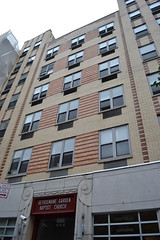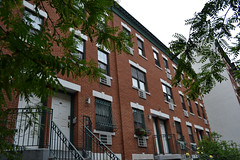 Ian Duncan The site BFC will develop, 11-17 Second Avenue – the current home of Mars Bar – is squeezed in among the much larger Avalon Bowery Place development
Ian Duncan The site BFC will develop, 11-17 Second Avenue – the current home of Mars Bar – is squeezed in among the much larger Avalon Bowery Place developmentFor Donald Capoccia, the developer behind 11-17 Second Avenue — the new apartment complex to be built on the current site of Mars Bar — the project is a return, after a decade away, to the East Village — the neighborhood where he launched his career and where he left his mark during the gentrification of the late 1990’s.
BFC Partners, Mr. Capoccia’s company, was responsible for the construction of hundreds of units of affordable housing in the East Village at a time when property values in the area were taking off. But the firm also became mired in a bitter dispute with residents over the destruction of community gardens to make way for Eastville Gardens, a mixed income development on Avenue C between East Seventh and East Eighth Streets.
Despite some rumblings over the loss of Mars Bar, a relic of the rough-and-tumble East Village of the 1980’s, the reception for the current project could hardly have been more different. In the past decade, the neighborhood has changed dramatically: when the 12-story building rises, it will stand among the much larger Avalon development on East Houston and Bowery. So far, BFC’s plan is going smoothly and Mr. Capoccia stands by his record.
“Housing production of that type in a neighborhood that was changing so rapidly is a great asset,” Mr. Capoccia said in a recent interview. Referring to low-income owners of units at the co-op he added, “community gardens are also a good asset but what was going on in the East Village then and where we are today, clearly a lot of these people wouldn’t be able to afford to live in the neighborhood.”
In 1999, community gardeners occupied the site of the Esperanza garden with a giant frog sculpture that doubled as a tree house. Even after the site had been bulldozed, a late-night party descended into chaos as 150 people stormed the lot, clashing with the police and injuring seven officers. Gardeners had previously launched a court case, but the New York Supreme Court ruled the project could go ahead. (In response to a suit filed by then-attorney general Eliot L. Spitzer, another Supreme Court ruling halted all work on other community gardens — the day after the East Village site was bulldozed.)
In contrast, the current Second Avenue plan sailed through Community Board 3 on the back of a unanimous vote last winter and eased through the City Council this spring. The Department of Housing Preservation Development and the City Planning Commission also lined up behind the project, even rewriting zoning regulations to make it possible.
City records show that 11-17 Associates LLC, the entity that owns the Second Avenue property has spent $57,500 since 2008 hiring lobbyists to target Community Board 3, the Department of Housing Preservation and Development, the City Planning Commission and city council members. (The records show that BFC spent $205,000 between 2003 and 2007)
Eric Bederman, a spokesman for the housing department, described its relationship with developers as “critical in our mission to create a more affordable and sustainable city.”
Mr. Capoccia has been involved in the affordable housing industry since Mayor Ed Koch first decided to sell off city-owned property for $1 in the early 80’s. After graduating from a master’s of urban planning at Hunter College, Mr. Capoccia put in a bid to develop a city-owned site on East Third Street. He completed the project in 1985 and moved into the renovated building himself.
In the last decade, BFC Partners turned its attention to bigger projects in East Harlem, Downtown Brooklyn and Williamsburg. But the company acquired 11-17 Second Avenue from the city in 2001 and for the current project, it will be combined with 9 Second Avenue, owned by the Urban Homestead Assistance Board, a non-profit organization. Mr. Capoccia’s company held onto the land, unwilling to develop it because of a deed that limited building to four apartments. The city refused to alter the deed unless the developer would provide affordable housing at the site, something Mr. Capoccia said would not have been financially sustainable.
An opportunity to break the impasse came in 2008 when the area around Second Avenue and East First Street was rezoned for the Inclusionary Housing Program, which gives developers the option to construct larger buildings than they otherwise could, providing they include affordable units.
When the regulation was written, a project involving the demolition of one affordable structure to make way for another had not been considered. Under the program, the current tenants would not have been offered their now-famous $10 apartment deal. At the suggestion of the Department of Housing Preservation and Development, the City Council changed the rules in April, allowing for previous tenants to take ownership of the new apartments. Without a plan to accommodate the existing tenants, Mr. Capoccia said the plan would likely have faced more opposition.
Under the inclusionary program, pricey market-rate apartments support the affordable ones, with no direct infusion of public money and Mr. Capoccia spoke with pride about how the buoyant housing market in the East Village is supporting the development of the 13 affordable units at 11-17. Mr. Capoccia noted the success of a high-end Bond Street condo he developed just three blocks away from the Second Avenue site. He sold his penthouse there for $15.8 million in April.
But, the developer recognizes that buildings like his latest cannot solve New York’s housing problems — the Second Avenue building will add four new affordable units to the city’s stock once the existing tenants have been accommodated. Under the rent stabilization regime, Mr. Capoccia said, there are too few incentives for people to enter the rental or ownership market at the bottom and gradually move up. In that situation, it does not make sense for developers to cater to lower income residents, he said. “It’s hard to imagine that the market is going to address the needs of households of limited means in the near future,” he added.
It is for that reason that Mr. Capoccia has carefully cultivated political connections. “You have to engage elected officials,” he said, because they “have to know the role” of affordable housing to the city’s economic health.
In 1998, Mr. Capoccia co-founded the New York State Association for Affordable Housing, which lobbies on behalf of companies in the industry. Mr. Capoccia still sits on the association’s board and in June it campaigned successfully against a plan to require affordable housing projects of more than 90 units to use union labor.
Since 1997, Mr. Capoccia has personally contributed $471,294 to political campaigns at the local, state and federal levels, supporting both Republicans and Democrats. Additionally, his companies contributed a further $67,010. Those donations have led to recurring questions about Mr. Capoccia’s business, which relies on city support. In June, Governor Andrew M. Cuomo appointed Mr. Capoccia to the Battery Park City Authority, a state agency responsible for developing the 92-acre downtown site. Mr. Capoccia donated $12,500 to Mr. Cuomo’s gubernatorial campaign.
The most serious claim came in 1999, when state Democrats accused Mayor Rudolph W. Giuliani of selling the Esparanza community garden to BFC without receiving competiting bids. The deal was pushed through in return for Mr. Capoccia and his company’s donations to his senate campaign, they said. Mr. Giuliani and BFC denied the claim.
During that period of heightened conflict, Mr. Capoccia told NPR he was “simply a builder” but his imprint on the neighborhood suggests a grander role. The work at 9-17 Second Avenue will be his 14th project in the East Village and between Avenues A and C north of East Seventh Street, almost every street has one of his buildings.
With the neighborhood changing rapidly in the late 90’s, Mr. Capoccia was often cast as an agent of gentrification. Two doors down from Eastville Gardens, BFC built the first luxury condominium building in Alphabet City, betting on rising property prices in the area. But while some of the company’s projects contained only market rate units, many have an affordable component. One project, named Del Este Village, created 100 affordable townhouses on six sites on East 10th, 11th and 13th streets.
His projects, Mr. Capoccia said, “have helped the East Village really evolve into the neighborhood it is today.”
Affordable housing in the East Village tracks the history of the city from the dark days of the 1970’s through the gentrification of the 1990’s and the rising property values of the last decade. Almost all of the city-owned land in the neighborhood has now been sold off, making the project at 9-17 Second Avenue one of the last of its kind.
For his part, Mr. Capoccia has no immediate plans for another project in the area, but is ruling nothing out. “What we’ve always found,” he said, “is when we start a project in a neighborhood, a lot of opportunities can come your way over a one and a half year period you’re present in a community and working on a project.”
Mapping BFC Projects
A list of construction projects involving BFC Partners in the East Village.
View BFC Partners East Village in a larger map







